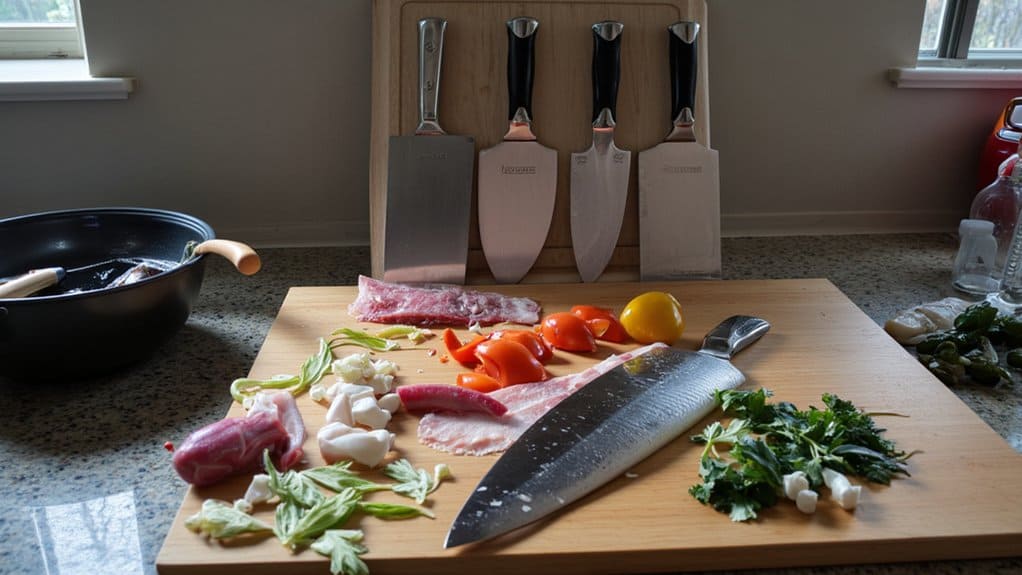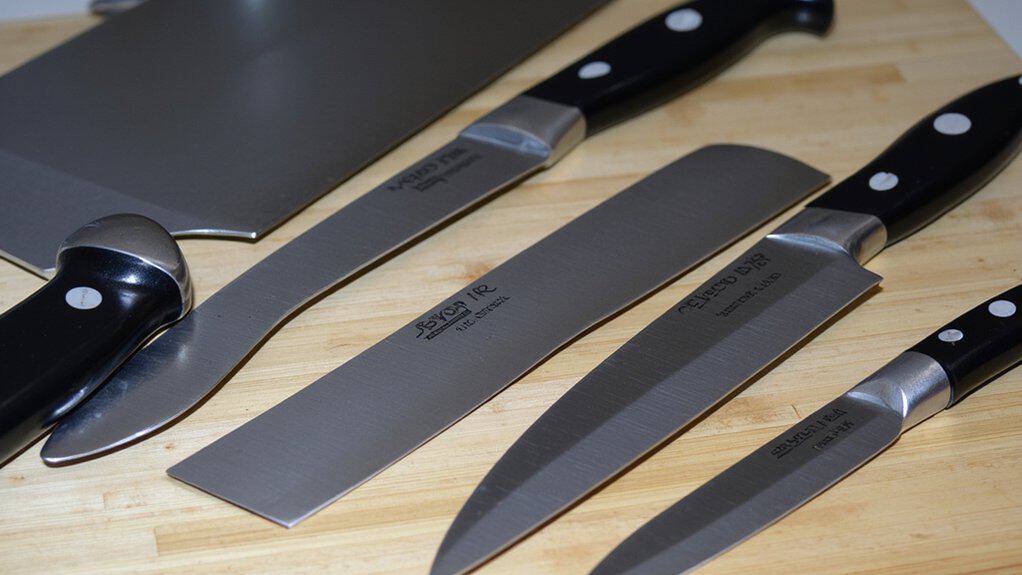Did you know that 68% of home cooks own at least five kitchen knives but only use two regularly? Let’s help you pick the right ones for your needs. Start by evaluating what you cook most often—daily meals or special baking projects. “A quality 8-inch chef’s knife is a must for versatility,” says Chef Maria Lopez. Curious which knives suit you best? Stick around to explore more tips.
Understanding Different Types of Kitchen Knives

Chef’s Knife: This is your go-to tool, usually 8 to 10 inches long, perfect for chopping, slicing, and dicing veggies or meats. You’ll find its broad blade, about 1.5 to 2 inches wide, gives control for most tasks. Keep it sharp for clean cuts every time.
Other Key Knives:
- Paring Knife: Grab this 3 to 4-inch blade for peeling apples or trimming small veggies. It’s precise for detailed work.
- Bread Knife: Use this serrated 8 to 10-inch knife to slice loaves without crushing them. Its jagged edge grips well.
- As knife expert John Cutler says, “Matching the right blade to the task saves time and effort.” So, understand these tools before picking one for your kitchen.
Assessing Your Cooking Needs and Style

How do you figure out which kitchen knives are best for you? Start by looking at your cooking habits and kitchen routines. Think about the meals you make most—like chopping veggies daily or slicing meat weekly.
Evaluate Your Needs
Consider these key points:
- Frequency: Do you cook every day or just on weekends? Daily cooks need versatile tools.
- Recipes: If you’re into baking, a bread knife with an 8-10 inch serrated edge is essential.
- “Match your knife to your tasks,” says chef Maria Lopez, a 20-year culinary veteran.
- Skill Level: Beginners should prioritize easy-to-handle knives, about 6-8 inches for control.
Next Steps
List your top 3 cooking tasks. Match knives to those needs for efficient prep within 10-15 minutes.
Evaluating Blade Materials and Construction

While picking the right knife starts with your cooking habits, it’s just as important to understand blade materials and construction. You’ve gotta know what makes a blade durable and sharp for your kitchen tasks. Let’s break it down.
Key Blade Materials
- Stainless Steel: Resists rust and is easy to clean, often 5-7 inches for chef’s knives.
- Carbon Steel: Holds a sharper edge but needs care to avoid rust; sharpen every 2-3 months.
- Ceramic: Stays sharp longer but can chip; not ideal for heavy chopping.
Construction Tips
- Look for full-tang blades (extending 4-6 inches into the handle) for balance.
- Check edge thickness; aim for 15-20 degrees for precision.
As chef Anna Reed says, “A well-made blade saves you time and frustration in daily prep.”
Considering Handle Design and Comfort
Ever wonder what makes a kitchen knife feel just right in your hand? It’s all about the handle design and comfort. A good handle fits your grip, reduces strain, and boosts control while you chop or slice.
Key Factors for Handle Comfort
- Material: Look for handles made of wood, plastic, or composite. Wood feels warm but needs care to avoid cracking.
- Shape and Size: Choose a handle around 4-5 inches long for balance. Chef Maria Lopez advises, “Test the grip; it shouldn’t slip even after 10 minutes of cutting.”
- Weight: Verify the handle isn’t too heavy or light compared to the blade.
Hold different knives for 2-3 minutes each. You’ll notice which design prevents fatigue and fits best.
Setting a Budget and Exploring Brands
Before diving into the world of kitchen knives, let’s tackle setting a budget and exploring brands to find the right tools for you. You’ve gotta decide how much you’re willing to spend first. Kitchen knives range from $10 for basic ones to over $200 for premium chef’s knives.
Budget Tips
- Set a Limit: Aim for $50-$100 for a solid starter set.
- Prioritize Needs: Spend more on a 8-inch chef’s knife if you cook daily.
Exploring Brands
- Research trusted names like Wüsthof or Victorinox for durability.
- Check reviews for knives with 3-5 year warranties.
As Chef Anna Reed says, “Invest in quality over quantity; a good knife lasts decades with proper care.” Start small, and build your collection wisely.


